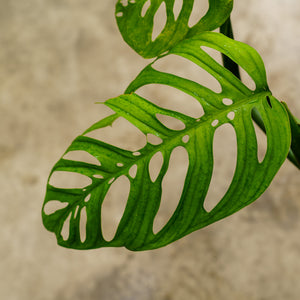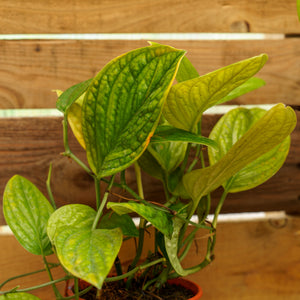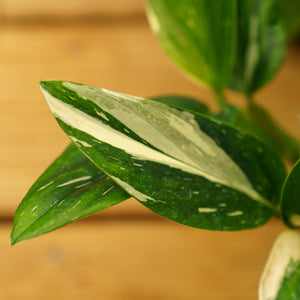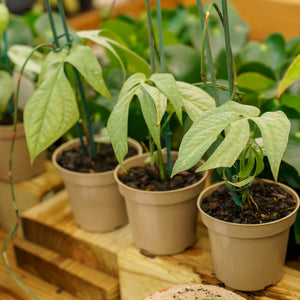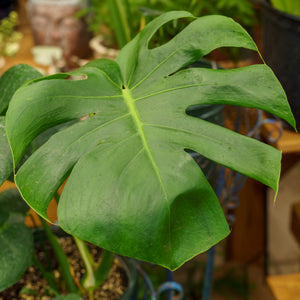The Monstera Guide
Monstera, known for its dramatic foliage and unique leaf patterns, brings a touch of the tropics to any garden or indoor space. With their large, fenestrated leaves and striking appearance, Monstera plants are perfect for adding an eye-catching focal point to borders, containers, and interior decor. These plants thrive in a variety of conditions and require minimal maintenance, making them an excellent choice for enhancing indoor plant collections, creating lush garden displays, or adding unique elements to landscapes. Explore our Monstera Guide to discover how to cultivate and care for these fascinating plants and incorporate them into your spaces for lasting beauty and enjoyment.
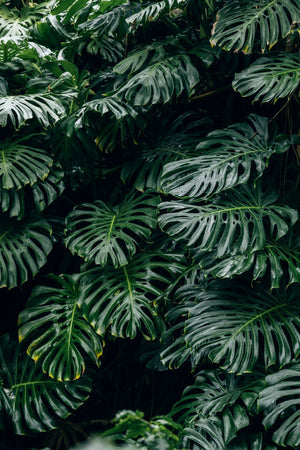
About
Monstera is a genus of about 50 species of flowering plants in the Araceae family, native to the tropical regions of Central and South America. The name "Monstera" comes from the Latin word for "monstrous" or "abnormal," a reference to the plant's unusual leaves with natural holes and splits. The most well-known species is Monstera deliciosa, commonly known as the Swiss Cheese Plant or Split-Leaf Philodendron, which is prized for its large, glossy, heart-shaped leaves with distinctive fenestrations (holes and splits).
Monstera plants are epiphytic or hemiepiphytic in nature, meaning they often grow on other plants or trees and derive their nutrients from the air, rain, and debris accumulating around them. This growth habit allows them to climb and reach sunlight in the dense tropical forests where they originate. Monstera plants develop aerial roots that help them anchor to surfaces and absorb moisture and nutrients.
The leaves of Monstera deliciosa can grow up to 3 feet long and develop more fenestrations as the plant matures. The plant also produces unique, edible fruit that has a flavor reminiscent of a combination of pineapple, banana, and mango, hence the name "deliciosa." However, the fruit should only be consumed when fully ripe, as it contains irritating compounds when unripe.
Another popular species is Monstera adansonii, also known as the Swiss Cheese Vine or Five-Holes Plant. This species has smaller, more delicate leaves with multiple holes and is often used in hanging baskets or as a climbing plant.
Monstera plants are not only aesthetically pleasing but also beneficial for indoor environments. They help purify the air by removing pollutants such as formaldehyde, benzene, and trichloroethylene. Their robust and lush foliage adds a touch of natural elegance to any space, making them a favorite among plant enthusiasts and interior designers.
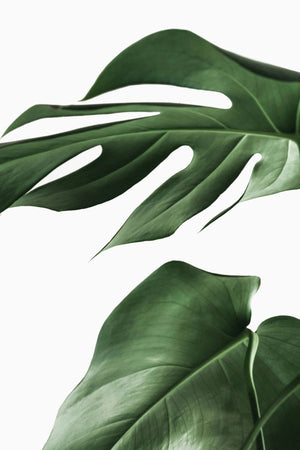
Planting
Creating the right environment is essential to the success of your Monstera. These plants thrive when their specific needs are met, ensuring lush growth and vibrant foliage.
- Soil: Monstera prefers a well-draining, peat-based potting mix that retains moisture without becoming waterlogged. A mix of potting soil, perlite, and orchid bark works well for most Monstera species, providing the right balance of drainage and moisture retention.
- Light: Monstera thrives in bright, indirect light. While they can tolerate lower light conditions, their growth and leaf fenestrations will be more pronounced with more light. Avoid direct sunlight, which can scorch the leaves, especially for indoor plants.
- Watering: Monstera requires regular watering to keep the soil evenly moist but not waterlogged. Water the plant thoroughly, allowing the top inch of soil to dry out between waterings. Reduce watering in the winter months when the plant's growth slows down.
- Humidity: Monstera plants prefer moderate to high humidity levels. Increase humidity by misting the leaves regularly, placing a humidifier nearby, or using a pebble tray with water. This is particularly important for indoor plants, especially in dry environments.
- Temperature: Monstera thrives in warm temperatures between 65-85°F (18-29°C). Protect the plant from cold drafts and sudden temperature changes, which can cause stress and damage the leaves. In colder climates, Monstera should be grown as a houseplant or in containers that can be brought indoors during the winter.
- Containers: Choose a pot with drainage holes to prevent waterlogging. Ensure the container is large enough to accommodate the plant's root system and allows for growth. Monstera plants can also benefit from support structures like stakes or moss poles to help them climb.
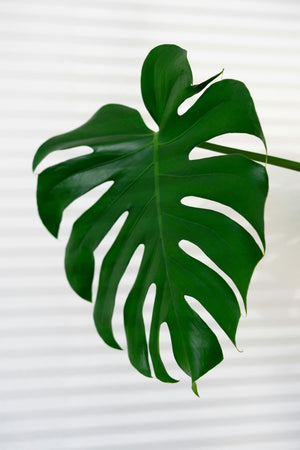
Care
Proper care is key to maintaining the health and beauty of your Monstera. By following these guidelines, you can enjoy a thriving plant that enhances your space.
- Watering: Keep the soil consistently moist but not waterlogged. Water the plant thoroughly, allowing the top inch of soil to dry out between waterings. Reduce watering in the winter months when the plant's growth slows down. Avoid using hard water, which can cause leaf spots.
- Fertilizing: Monstera benefits from regular feeding during the growing season. Use a balanced, water-soluble fertilizer diluted to half strength every 4-6 weeks from spring through fall. Avoid over-fertilizing, as this can lead to salt buildup and damage the plant.
- Pruning: Remove any yellow or damaged leaves to maintain the plant's appearance and health. Use clean, sharp scissors to avoid introducing infections. Prune back the tips of the stems to encourage bushier growth if desired. Regular pruning helps maintain the desired shape and size of the plant.
- Pests and Diseases: Monstera can be susceptible to pests such as spider mites, aphids, and mealybugs. Inspect your plants regularly and treat any infestations promptly with appropriate organic or chemical controls. Maintain proper watering and humidity to reduce the risk of pests and diseases.
- Repotting: Repot Monstera every 2-3 years or when it outgrows its current container. Spring is the best time to repot. Use fresh potting mix and ensure the new pot has adequate drainage.
- Support: Provide support for climbing Monstera species by using stakes, moss poles, or trellises. This will help the plant grow vertically and develop larger, more fenestrated leaves.
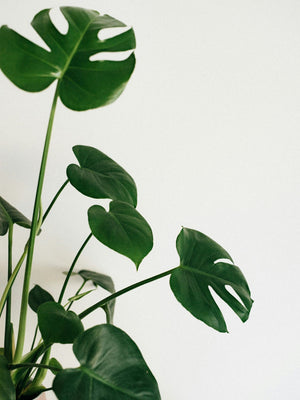
How To Use
Monstera’s stunning foliage and adaptable growth habits make it a versatile choice for enhancing various spaces. Whether indoors or outdoors, Monstera provides endless opportunities for creative use.
- Indoor Decor: Monstera makes stunning houseplants, adding a touch of tropical elegance to any room. Place them in bright, indirect light and use decorative pots to enhance their appearance. Their large, fenestrated leaves make them a striking focal point in any interior setting.
- Office Plants: Monstera's ability to thrive in bright, indirect light makes them ideal for office environments. Place them on desks, shelves, or in corners to bring a touch of nature to the workspace. Their air-purifying properties also help improve indoor air quality.
- Patios and Balconies: Grow Monstera in containers to create portable displays for patios, balconies, or entryways. Use decorative pots to enhance their sculptural forms and arrange them in groupings for added impact.
- Living Walls: Use Monstera to create living wall displays. Plant them in vertical planters or frames to add a unique, textural element to indoor or outdoor walls. Their trailing or climbing habits can enhance the visual appeal of vertical gardens.
- Ground Cover: Some smaller Monstera species can be used as ground cover in shaded areas of the garden. Their dense foliage helps suppress weeds and retain soil moisture.
- Terrariums: Small Monstera species can be used in terrariums, where their humidity needs can be easily met. Combine them with other tropical plants to create a lush, miniature ecosystem.
- Public Spaces: Monstera is often used in public spaces like hotel lobbies, restaurants, and office buildings to create a lush, inviting atmosphere. Their low maintenance requirements and striking appearance make them ideal for such settings.
Conclusion
Monstera is a captivating and versatile addition to any garden or indoor space. With their dramatic foliage, unique leaf patterns, and minimal maintenance requirements, Monstera plants bring a touch of tropical elegance to your environment. Their adaptability to various growing conditions and ease of care make them a favorite among gardeners and indoor plant enthusiasts of all levels. By following proper planting and maintenance techniques, you can fully harness the potential of Monstera to enhance your garden and home, creating a lasting impact.
Whether you seek to create stunning indoor displays, enhance your patio garden, or add visual interest to living walls and containers, Monstera can fulfill a variety of roles in your landscape and decor. Place them individually to showcase their unique beauty, or combine different species and varieties for a dynamic and visually appealing display. Monstera's ability to thrive in diverse environments and provide year-round interest adds to their appeal, making them a valuable addition to any collection.
Beyond their ornamental value, Monstera contributes to the overall health and beauty of your garden ecosystem by providing habitat for beneficial insects and adding structure to your landscape. Their low maintenance requirements and resilience make them an excellent choice for sustainable gardening. With their enduring beauty, versatility, and ecological benefits, Monstera plants bring natural allure and vibrant charm to your outdoor and indoor environments, enriching your plant collection and enhancing the overall beauty of your space.

